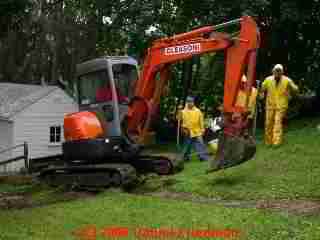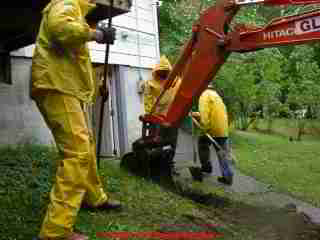 How & When to Dig (Excavate) to Locate Septic Tank or Drainfield
How & When to Dig (Excavate) to Locate Septic Tank or Drainfield
- POST a QUESTION or COMMENT about digging to find the location of septic tank, drainfield, D-box, and septic piping or other septic system compoinents
When to dig to find the septic system, tank or drainfield or soakaway beds or pipes or D-box:
We would prefer not to have to dig up the whole yard to find the septic tank or other septic components, right?
This article and our accompanying septic system location videos explains how to find the leach field or drainfield portion of a septic system including cases when digging or exploratory excavation are in fact needed and justified. We include sketches and photos that help you learn what to look for, and we describe several methods useful for finding buried drainfield components. (Septic drain fields are also called soil absorption systems or seepage beds.)
InspectAPedia tolerates no conflicts of interest. We have no relationship with advertisers, products, or services discussed at this website.
- Daniel Friedman, Publisher/Editor/Author - See WHO ARE WE?
How to use Excavating to find Drainfield Trenches & Their Condition
A Guide to Finding the Drainfield - Part 7
A homeowner might dig a test hole where s/he thinks a leach line is present based on the site observations above.
The depth of a leach line may vary by site conditions but normally would be 24" or so.
A septic contractor might take a different approach and simply dig a trench across the property, figuring that the soil cut will come across the buried line.
The dig-across-the-whole-property approach might be reasonable only if we already know that the system has to be replaced, since the backhoe is likely to destroy the buried piping when it "finds" it.
Why we Like Digging by Hand First and Excavating by Backhoe Second
Most people prefer to use equipment to dig at building sites - it's faster, physically easier (to operate a machine than to wield a shovel), and it is probably more profitable. Certainly in many instances a backhoe is the only reasonable way to dig. But we prefer to try digging first by hand whenever possible. Hand excavation does the least damage to a building site when looking for septic components because:
- Hand excavation does the least damage to the site, yard, plants, etc.
- Hand excavation can begin gently, right by the building wall, without even waiting for equipment to show up
- Hand excavation can be done by an energetic owner or her friends (but see SEPTIC & CESSPOOL SAFETY first)
- Hand excavation avoids destroying steel septic tanks and covers (but see SEPTIC & CESSPOOL SAFETY first)
- Hand excavation (or a careful backhoe operator) won't leave you with a newly "explored" but now totally destroyed septic system - so you cannot use the building plumbing and are pressured to accept whatever repair bid the contractor offers. (Trying to get septic repair cost estimates before any excavating is tough because the contractor knows that there are too many unknowns - but press for upper reasonable limits on cost)
Where to Excavate to Look for Septic or Sewer Components
But eventually, it's time to excavate - because your hand digging was fruitless or because you've found that extensive exploration and septic repair are probably needed. Usually an experienced excavation contractor has a pretty good eye for guessing at where another excavator would have dug to place a drainfield trench, D-box, or other septic system component. Walking the site and ruling in or out probable areas can significantly reduce the extent of excavation necessary.
How to Think First and Dig Second - Narrowing the Search for the Drainfield

See VISUAL CLUES LOCATE the SEPTIC TANK ,
Areas Not Likely, and
Visual Clues to Location for details on narrowing down the search for septic components before you dig.
Septic Excavation Case Illustrated - step by step excavation to replace a sewer line
Our sewer line case study shows the steps in finding and excavating septic components in detail at Sewer Line Replacement Procedure - details of when, how, and why to replace a buried drain line between a house and septic tank
Digging up a Failed Drainfield
Of course, if the leach field already needs replacement, one can probably find the end of a leach line by noticing where effluent is breaking out to the surface.
...
Continue reading at REASONS to FIND THE DRAINFIELD or select a topic from the closely-related articles below, or see the complete ARTICLE INDEX.
Or see these
Recommended Articles
- CLEARANCE DISTANCES, SEPTIC SYSTEM
- SEPTIC COMPONENT LOCATIONS
- SEPTIC DRAINFIELD INSPECTION & TEST - home
- SEPTIC DRAINFIELD LOCATION
- DRAINFIELD PIPE LOCATION, PRECISE
- EXCAVATE to LOCATE DRAINFIELD
- REASONS to FIND THE DRAINFIELD
- RECORDS to LOCATE the DRAINFIELD
- SURPRISING DRAINFIELD LOCATIONS
- UNLIKELY DRAINFIELD LOCATIONS
- VISUAL CLUES LOCATE the DRAINFIELD
- VISUAL CLUES LOCATE the SEPTIC TANK
- SEPTIC DRAINFIELD SIZE
- SEPTIC DRAINFIELD SHAPE
- More videos on septic system location & maintenance are at SEPTIC VIDEOS
Suggested citation for this web page
EXCAVATE to LOCATE DRAINFIELD at InspectApedia.com - online encyclopedia of building & environmental inspection, testing, diagnosis, repair, & problem prevention advice.
Or see this
INDEX to RELATED ARTICLES: ARTICLE INDEX to SEPTIC SYSTEMS
Or use the SEARCH BOX found below to Ask a Question or Search InspectApedia
Ask a Question or Search InspectApedia
Try the search box just below, or if you prefer, post a question or comment in the Comments box below and we will respond promptly.
Search the InspectApedia website
Note: appearance of your Comment below may be delayed: if your comment contains an image, photograph, web link, or text that looks to the software as if it might be a web link, your posting will appear after it has been approved by a moderator. Apologies for the delay.
Only one image can be added per comment but you can post as many comments, and therefore images, as you like.
You will not receive a notification when a response to your question has been posted.
Please bookmark this page to make it easy for you to check back for our response.
IF above you see "Comment Form is loading comments..." then COMMENT BOX - countable.ca / bawkbox.com IS NOT WORKING.
In any case you are welcome to send an email directly to us at InspectApedia.com at editor@inspectApedia.com
We'll reply to you directly. Please help us help you by noting, in your email, the URL of the InspectApedia page where you wanted to comment.
Citations & References
In addition to any citations in the article above, a full list is available on request.
- New York State Department of Health, APPENDIX 75-A WASTEWATER TREATMENT STANDARDS - INDIVIDUAL HOUSEHOLD SYSTEMS , [PDF] New York State Department of Health, 3 February 2010, retrieved 3/1/2010, original source: https://www.health.ny.gov/regulations/nycrr/title_10/part_75/appendix_75-a.htm
- Percolation Testing Manual, CNMI Division of Environmental Quality, Gualo Rai, Saipan provides an excellent English Language manual guide for soil percolation testing. Original source: www.deq.gov.mp/artdoc/Sec6art108ID255.pdf
- Soil Test Pit Preparation, fact sheet, Oregon DEQ Department of Environmental Quality, original source www.deq.state.or.us/wq/pubs/factsheets/onsite/testpitprep.pdf The Oregon DEQ onsite water quality program can be contacted at 811 South Ave, Portland OR 97204, 800-452-4011 or see http://www.oregon.gov/DEQ/
- Thanks to reader Michael Roth for technical link editing 6/29/09.
- SEPTIC TANK/SOIL-ABSORPTION SYSTEMS: HOW TO OPERATE & MAINTAIN [PDF] - , Equipment Tips, U.S. Department of Agriculture, 8271 1302, 7100 Engineering, 2300 Recreation, September 1982, web search 08/28/2010, original source: http://www.fs.fed.us/t-d/pubs/pdfimage/82711302.pdf.
- Pennsylvania State Fact Sheets relating to domestic wastewater treatment systems include
- Pennsylvania State Wastewater Treatment Fact Sheet SW-161, Septic System Failure: Diagnosis and Treatment
- Pennsylvania State Wastewater Treatment Fact Sheet SW-162, The Soil Media and the Percolation Test
- Pennsylvania State Wastewater Treatment Fact Sheet SW-l64, Mound Systems for Wastewater Treatment
- Pennsylvania State Wastewater Treatment Fact Sheet SW-165, Septic Tank-Soil Absorption Systems
- Document Sources used for this web page include but are not limited to: Agricultural Fact Sheet #SW-161 "Septic Tank Pumping," by Paul D. Robillard and Kelli S. Martin. Penn State College of Agriculture - Cooperative Extension, edited and annotated by Dan Friedman (Thanks: to Bob Mackey for proofreading the original source material.
- Advanced Onsite Wastewater Systems Technologies, Anish R. Jantrania, Mark A. Gross. Anish Jantrania, Ph.D., P.E., M.B.A., is a Consulting Engineer, in Mechanicsville VA, 804-550-0389 (2006). Outstanding technical reference especially on alternative septic system design alternatives. Written for designers and engineers, this book is not at all easy going for homeowners but is a text I recommend for professionals--DF.
- Builder's Guide to Wells and Septic Systems, Woodson, R. Dodge: $ 24.95; MCGRAW HILL B; TP; Quoting from Amazon's description: For the homebuilder, one mistake in estimating or installing wells and septic systems can cost thousands of dollars. This comprehensive guide filled with case studies can prevent that. Master plumber R. Dodge Woodson packs this reader-friendly guide with guidance and information, including details on new techniques and materials that can economize and expedite jobs and advice on how to avoid mistakes in both estimating and construction. Chapters cover virtually every aspect of wells and septic systems, including on-site evaluations; site limitations; bidding; soil studies, septic designs, and code-related issues; drilled and dug wells, gravel and pipe, chamber-type, and gravity septic systems; pump stations; common problems with well installation; and remedies for poor septic situations. Woodson also discusses ways to increase profits by avoiding cost overruns.
- In addition to citations & references found in this article, see the research citations given at the end of the related articles found at our suggested
CONTINUE READING or RECOMMENDED ARTICLES.
- Carson, Dunlop & Associates Ltd., 120 Carlton Street Suite 407, Toronto ON M5A 4K2. Tel: (416) 964-9415 1-800-268-7070 Email: info@carsondunlop.com. Alan Carson is a past president of ASHI, the American Society of Home Inspectors.
Thanks to Alan Carson and Bob Dunlop, for permission for InspectAPedia to use text excerpts from The HOME REFERENCE BOOK - the Encyclopedia of Homes and to use illustrations from The ILLUSTRATED HOME .
Carson Dunlop Associates provides extensive home inspection education and report writing material. In gratitude we provide links to tsome Carson Dunlop Associates products and services.


